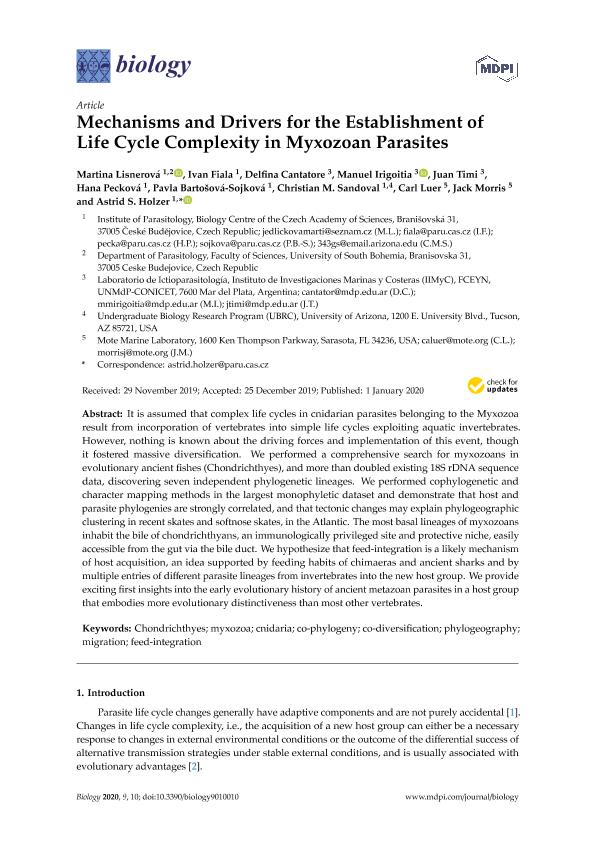Mostrar el registro sencillo del ítem
dc.contributor.author
Lisnerová, Martina

dc.contributor.author
Fiala, Ivan
dc.contributor.author
Cantatore, Delfina María Paula

dc.contributor.author
Irigoitia, Manuel Marcial

dc.contributor.author
Timi, Juan Tomas

dc.contributor.author
Pecková, Hana
dc.contributor.author
Bartoová Sojková, Pavla
dc.contributor.author
Sandoval, Christrian M.
dc.contributor.author
Luer, Carl
dc.contributor.author
Morris, Jack
dc.contributor.author
Holzer, Astrid Sybylle

dc.date.available
2021-03-25T18:51:48Z
dc.date.issued
2020-01
dc.identifier.citation
Lisnerová, Martina; Fiala, Ivan; Cantatore, Delfina María Paula; Irigoitia, Manuel Marcial; Timi, Juan Tomas; et al.; Mechanisms and drivers for the establishment of life cycle complexity in Myxozoan parasites; Multidisciplinary Digital Publishing Institute; Biology; 9; 1; 1-2020; 1-16
dc.identifier.uri
http://hdl.handle.net/11336/128947
dc.description.abstract
It is assumed that complex life cycles in cnidarian parasites belonging to the Myxozoa result from incorporation of vertebrates into simple life cycles exploiting aquatic invertebrates. However, nothing is known about the driving forces and implementation of this event, though it fostered massive diversification. We performed a comprehensive search for myxozoans in evolutionary ancient fishes (Chondrichthyes), and more than doubled existing 18S rDNA sequence data, discovering seven independent phylogenetic lineages. We performed cophylogenetic and character mapping methods in the largest monophyletic dataset and demonstrate that host and parasite phylogenies are strongly correlated, and that tectonic changes may explain phylogeographic clustering in recent skates and softnose skates, in the Atlantic. The most basal lineages of myxozoans inhabit the bile of chondrichthyans, an immunologically privileged site and protective niche, easily accessible from the gut via the bile duct. We hypothesize that feed-integration is a likely mechanism of host acquisition, an idea supported by feeding habits of chimaeras and ancient sharks and by multiple entries of different parasite lineages from invertebrates into the new host group. We provide exciting first insights into the early evolutionary history of ancient metazoan parasites in a host group that embodies more evolutionary distinctiveness than most other vertebrates.
dc.format
application/pdf
dc.language.iso
eng
dc.publisher
Multidisciplinary Digital Publishing Institute
dc.rights
info:eu-repo/semantics/openAccess
dc.rights.uri
https://creativecommons.org/licenses/by/2.5/ar/
dc.subject
CHONDRICHTHYES
dc.subject
MYXOZOA
dc.subject
CNIDARIA
dc.subject
CO-PHYLOGENY
dc.subject
CO-DIVERSIFICATION
dc.subject
PHYLOGEOGRAPHY
dc.subject
MIGRATION
dc.subject
FEED-INTEGRATION
dc.subject.classification
Otros Tópicos Biológicos

dc.subject.classification
Ciencias Biológicas

dc.subject.classification
CIENCIAS NATURALES Y EXACTAS

dc.title
Mechanisms and drivers for the establishment of life cycle complexity in Myxozoan parasites
dc.type
info:eu-repo/semantics/article
dc.type
info:ar-repo/semantics/artículo
dc.type
info:eu-repo/semantics/publishedVersion
dc.date.updated
2021-02-18T15:20:05Z
dc.identifier.eissn
2079-7737
dc.journal.volume
9
dc.journal.number
1
dc.journal.pagination
1-16
dc.journal.pais
Suiza

dc.journal.ciudad
Basel
dc.description.fil
Fil: Lisnerová, Martina. Czech Academy of Sciences; República Checa
dc.description.fil
Fil: Fiala, Ivan. Czech Academy of Sciences; República Checa
dc.description.fil
Fil: Cantatore, Delfina María Paula. Consejo Nacional de Investigaciones Científicas y Técnicas. Centro Científico Tecnológico Conicet - Mar del Plata. Instituto de Investigaciones Marinas y Costeras. Universidad Nacional de Mar del Plata. Facultad de Ciencias Exactas y Naturales. Instituto de Investigaciones Marinas y Costeras; Argentina
dc.description.fil
Fil: Irigoitia, Manuel Marcial. Consejo Nacional de Investigaciones Científicas y Técnicas. Centro Científico Tecnológico Conicet - Mar del Plata. Instituto de Investigaciones Marinas y Costeras. Universidad Nacional de Mar del Plata. Facultad de Ciencias Exactas y Naturales. Instituto de Investigaciones Marinas y Costeras; Argentina
dc.description.fil
Fil: Timi, Juan Tomas. Consejo Nacional de Investigaciones Científicas y Técnicas. Centro Científico Tecnológico Conicet - Mar del Plata. Instituto de Investigaciones Marinas y Costeras. Universidad Nacional de Mar del Plata. Facultad de Ciencias Exactas y Naturales. Instituto de Investigaciones Marinas y Costeras; Argentina
dc.description.fil
Fil: Pecková, Hana. Czech Academy of Sciences; República Checa
dc.description.fil
Fil: Bartoová Sojková, Pavla. Czech Academy of Sciences; República Checa
dc.description.fil
Fil: Sandoval, Christrian M.. Czech Academy of Sciences; República Checa
dc.description.fil
Fil: Luer, Carl. Mote Marine Laboratory; Estados Unidos
dc.description.fil
Fil: Morris, Jack. Mote Marine Laboratory; Estados Unidos
dc.description.fil
Fil: Holzer, Astrid Sybylle. Czech Academy of Sciences; República Checa
dc.journal.title
Biology
dc.relation.alternativeid
info:eu-repo/semantics/altIdentifier/url/https://www.mdpi.com/2079-7737/9/1/10
dc.relation.alternativeid
info:eu-repo/semantics/altIdentifier/doi/https://doi.org/10.3390/biology9010010
Archivos asociados
